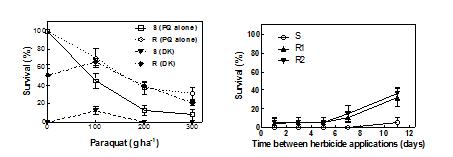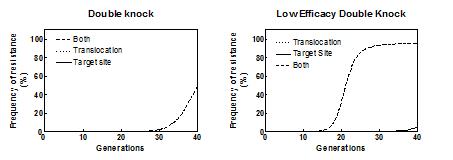Roundup Ready - Canola and Glyphosate Resistance
| Date: 26 Nov 2009

GRDC code
UA00088 and UA00104
There are currently 92 confirmed glyphosate resistant weed populations in Australia. Three weed species have evolved glyphosate resistance to date: annual ryegrass, barnyard grass and liverseed grass. Glyphosate resistance occurs where glyphosate is used intensively, no other herbicides are used and no weed control is used after the glyphosate application. While the threat of glyphosate resistance is high in no-till cropping systems, recent research suggests crop competition and alternative weed management strategies are effective in managing glyphosate resistant populations.
Growing Roundup Ready canola will increase the risk of glyphosate resistance in weeds. This is because glyphosate will be applied later, and therefore applies more selection pressure, than a pre-sowing application of glyphosate. It is important that Roundup Ready canola is used in a way that will not significantly increase the risk of glyphosate resistance occurring.
Getting the best out of Roundup Ready canola will mean using the crop as part of a multiple year weed management program. Roundup Ready canola allows a broad-spectrum herbicide to be used in crop to control most weed species. It would be sensible to take advantage of this feature when planning a rotation. Experience from 2008 indicates two applications of glyphosate provided better weed control than one application. Two applications should certainly used in situations with higher weed burden.
Reducing the risk of glyphosate resistance requires action in the rest of the rotation. It is possible to take advantage of the rarity of glyphosate resistance and the lack of fitness of glyphosate resistant weeds. Sowing a competitive crop in the year after growing Roundup Ready canola will maximise the impact of crop competition on glyphosate resistant annual ryegrass. This will also help maximise the benefits of weed control from the Roundup Ready canola. Not using glyphosate in the year after growing Roundup Ready canola will do most to reduce the selection pressure for glyphosate resistance. However, benefits will occur from a crop year without glyphosate application elsewhere in the rotation.
Including other weed management strategies throughout the rotation will also help manage the risk of glyphosate resistant weeds. Recent survey work has identified competition and seed set control as important in reducing the amount of glyphosate resistant weeds in paddocks.
Herbicide resistance in other herbicide tolerant canolas
There are two other types of herbicide tolerant canola available to growers; TT canola and Clearfield canola. Weeds can become resistant to both imidazolinones and to triazines and do so more rapidly than they do to glyphosate. Continuing to rely on triazines or imidazolinones for weed control will also lead to weed resistance. Annual ryegrass has already evolved resistance to both these herbicide groups.
In planning the use of herbicide tolerant canola, it will be important to choose the type most appropriate for the situation. This will be influenced by soil type, rainfall, weed spectrum and herbicide resistance risk. It is also important to maintain an integrated weed management system including opportunities for effective control of difficult to manage weeds.
Double knocking weeds
A strategy for driving weed numbers down is to employ various forms of double knocking. Double knocking should be thought of as using a second weed control tactic to control the survivors of a previous tactic. Controlling seed set of surviving weeds is an effective way of reducing weed numbers and the impact of herbicide resistance. There are many possible strategies for controlling weed survivors, including cutting hay or silage, crop topping, chaff carts or burning stubbles. However, seed set control tactics need to be planned to obtain the greatest benefits.
The double knockdown, glyphosate followed by paraquat or paraquat/diquat, has been promoted as a way of reducing the risk of glyphosate resistance. However, a poorly applied double knockdown risks increasing the risks of glyphosate resistance. To get the most out the double knockdown, the paraquat/diquat application needs to occur at an effective rate of 1.3 L ha-1 or more. Secondly, the second herbicide application should ideally be made within 5 days of the glyphosate application.
Figure 1. (Left) Effect of paraquat rate on efficacy of the double knockdown on glyphosate susceptible (S) and glyphosate-resistant (R) populations of annual ryegrass. (Right) Effect of time between glyphosate and paraquat applications of the double knockdown on efficacy against glyphosate-susceptible (S) and -resistant (R1, R2) populations of annual ryegrass. 
Figure 2.
Predicted evolution of glyphosate resistance in fields containing the translocation mechanism, the target site mechanism or both mechanisms where the double knock is employed as the knockdown treatment every year (left) or where a low efficacy double knock is employed every year (right).
Contact details
Dr. Christopher Preston
University of Adelaide
PMB 1 Glen Osmond SA 5064
Ph: 08 8303 7237
christopher.preston@adelaide.edu.au
Was this page helpful?
YOUR FEEDBACK
